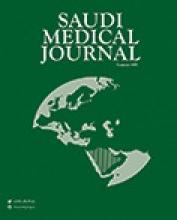Abstract
OBJECTIVE: Congenital paraesophageal hernia is a rare condition in the pediatric age group. The symptomatology of these patients is usually non-specific in the form of repeated attacks of chest infection and/or recurrent attacks of vomiting but can be associated with serious complications such as intrathoracic gastric volvulus.
METHODS: Between 1989 and 1997, 6 children with paraesophageal hernia were treated at our hospital.
RESULTS: Six children (4 males and 2 females) were treated for congenital paraesophageal hernia. Their age at presentation ranged from 2 days to 21/2 years (mean 1.3 years). Two presented with recurrent chest infection, while 3 others had recurrent attacks of vomiting with fullness and pain in the epigastrium in one of them. One of our patients presented acutely immediately after birth with respiratory distress while another was found to have intrathoracic gastric volvulus. Chest x-ray was suggestive of paraesophageal hernia in all of them but the diagnosis was confirmed by Barium swallow and meal. Intraoperatively there was a hernial sac in all of them. The surgical treatment consisted of excision of the hernial sac after reducing the stomach and tightening of the crura of the esophageal hiatus. Nissen's fundoplication was added in 3 patients, but in one of them this was dismantled because of tight repair. Anterior and fundal gastropexy was added in one patient, while 2 had tightening of the crura only.
CONCLUSION: Congenital paraesophageal hernia, although rare in the pediatric age group, can present acutely with respiratory distress or intrathoracic gastric volvulus. Physicians caring for these patients should be aware of such a presentation and complication and paraesophageal hernia should be included in the differential diagnosis of children with repeated attacks of chest infection and/or vomiting. The rarity of this condition in children makes it difficult to evaluate the true necessity of adding an antireflux procedure in these patients. We feel some form of gastropexy may be a more appropriate procedure to be added to the repair.
- Copyright: © Saudi Medical Journal
This is an open-access article distributed under the terms of the Creative Commons Attribution-Noncommercial-Share Alike 3.0 Unported, which permits unrestricted use, distribution, and reproduction in any medium, provided the original work is properly cited.






